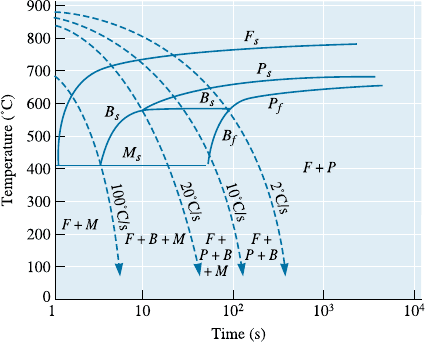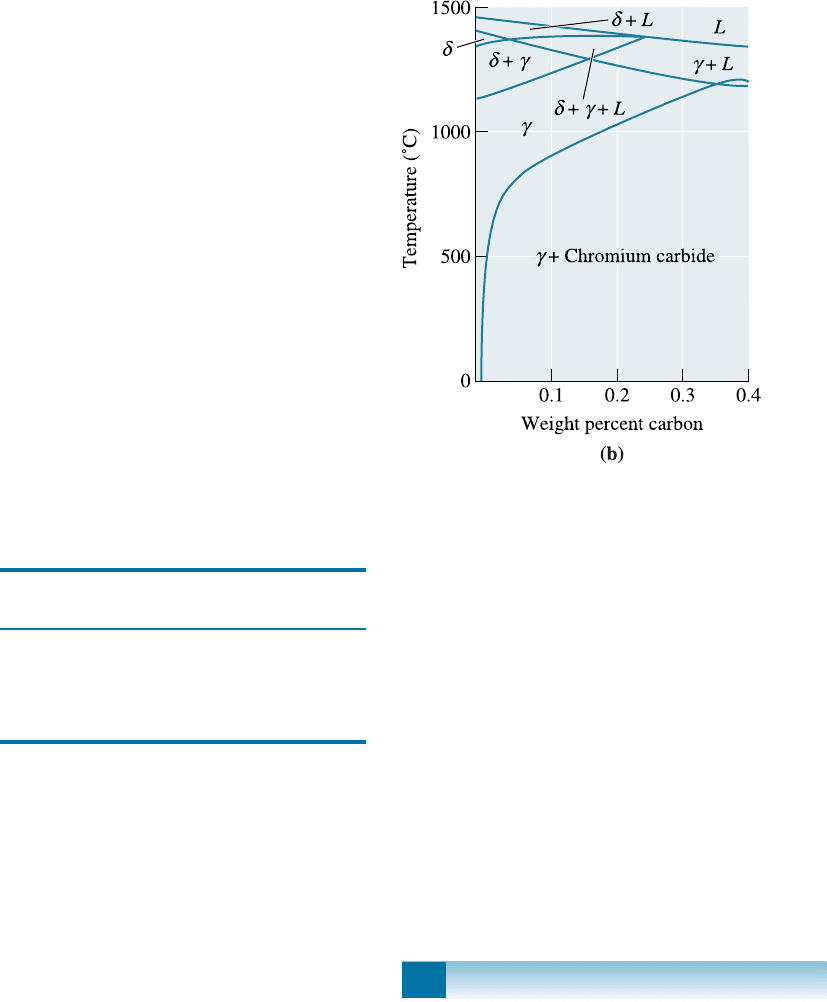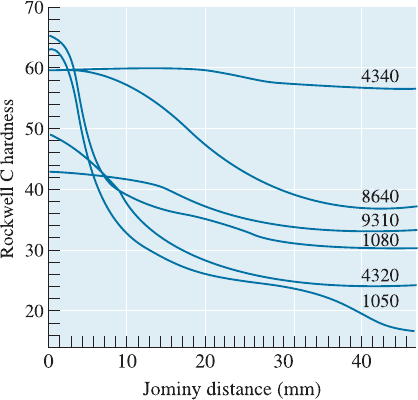Askeland D.R., Fulay P.P. Essentials of Materials Science & Engineering
Подождите немного. Документ загружается.

Isothermal annealing Heat treatment of a steel by austenitizing, cooling rapidly to a temper-
ature between the A
1
and the nose of the TTT curve, and holding until the austenite transforms to
pearlite.
Jominy distance The distance from the quenched end of a Jominy bar. The Jominy distance is
related to the cooling rate.
Jominy test The test used to evaluate hardenability. An austenitized steel bar is quenched at one
end only, thus producing a range of cooling rates along the bar.
Malleable cast iron Cast iron obtained by a lengthy heat treatment, during which cementite
decomposes to produce rounded clumps of graphite. Good strength, ductility, and toughness are
obtained as a result of this structure.
Maraging steels A special class of alloy steels that obtain high strengths by a combination of the
martensitic and age-hardening reactions.
Marquenching Quenching austenite to a temperature just above the M
S
and holding until the
temperature is equalized throughout the steel before further cooling to produce martensite. This
process reduces residual stresses and quench cracking. Also known as martempering.
Microalloyed steels High-strength steels containing relatively low carbon but small amounts of
alloying elements such as Mn, Nb, Ti, and V added to enhance strength and hardenability.
Nitriding Hardening the surface of steel with nitrogen obtained from a special gas atmosphere.
Nodulizing The addition of magnesium to molten cast iron to cause the graphite to precipitate
as spheres rather than as flakes during solidification.
Normalizing A simple heat treatment obtained by austenitizing and air cooling to produce a fine
pearlitic structure. This can be done for steels and cast irons.
Pig iron The molten iron produced in a blast furnace also known as hot metal. It contains about
95% iron, 4% carbon, 0.3–0.9% silicon, 0.5% Mn, and 0.025–0.05% each of sulfur, phosphorus,
and titanium.
Process anneal A low-temperature heat treatment used to eliminate all or part of the e¤ect of
cold working in steels.
Quench cracks Cracks that form at the surface of a steel during quenching due to tensile re-
sidual stresses that are produced because of the volume change that accompanies the austenite-to-
martensite transformation.
Retained austenite Austenite that is unable to transform into martensite during quenching
because of the volume expansion associated with the reaction.
Second stage graphitization The second step in the heat treatment of malleable irons that are to
have a ferritic matrix. The iron is cooled slowly from the first stage graphitization temperature so
that austenite transforms to ferrite and graphite rather than to pearlite.
Secondary hardening peak Unusually high hardness in a steel tempered at a high temperature
caused by the precipitation of alloy carbides.
Sensitization When heated to a temperature of @480–860
C, chromium carbides precipitate
along grain boundaries rather than within grains, causing chromium depletion in the interior.
This causes the stainless steel to corrode very easily.
Spheroidite A microconstituent containing coarse spheroidal cementite particles in a matrix of
ferrite, permitting excellent machining characteristics in high-carbon steels.
C HA P T E R 1 3 Heat Treatment of Steels and Cast Irons430

Stainless steels A group of ferrous alloys that contain at least 11% Cr, providing extraordinary
corrosion resistance.
Tempered martensite The microconstituent of ferrite and cementite formed when martensite is
tempered.
Tool steels A group of high-carbon steels that provide combinations of high hardness, tough-
ness, or resistance to elevated temperatures.
Vermicular graphite The rounded, interconnected graphite that forms during the solidification
of cast iron. This is the intended shape in compacted-graphite iron, but it is a defective shape in
ductile iron.
White cast iron Cast iron that produces cementite rather than graphite during solidification.
The white irons are hard and brittle.
PROBLEMS
3
Section 13-1 Designations and Classification of
Steels
13-1 What is the di¤erence between cast iron and
steels?
13-2 What do A
1
, A
3
, and A
cm
temperatures refer to?
Are these temperatures constant?
13-3 Calculate the amounts of ferrite, cementite, pri-
mary microconstituent, and pearlite in the fol-
lowing steels:
(a) 1015 (b) 1035 (c) 1095 (d) 10130
13-4 Estimate the AISI-SAE number for steels having
the following microstructures:
(a) 38% pearlite-62% primary ferrite
(b) 93% pearlite-7% primary cementite
(c) 97% ferrite-3% cementite
(d) 86% ferrite-14% cementite
13-5 Complete the following table:
1035
Steel
10115
Steel
A
1
temperature
A
3
or A
cm
temperature
Full annealing temperature
Normalizing temperature
Process annealing
temperature
Spheroidizing temperature
13-6 What do the terms low-, medium-, and high-
carbon steels mean?
Section 13-2 Simple Heat Treatments
Section 13-3 Isothermal Heat Treatments
13-7 Explain the following heat treatments: (a) proc-
ess anneal, (b) austenitizing, (c) annealing, (d)
normalizing, and (e) quenching.
13-8 Explain why, strictly speaking, TTT diagrams
can be used for isothermal treatments only.
13-9 In a pearlitic 1080 steel, the cementite platelets
are 4 10
5
cm thick, and the ferrite platelets
are 14 10
5
cm thick. In a spheroidized 1080
steel, the cementite spheres are 4 10
3
cm
in diameter. Estimate the total interface area
between the ferrite and cementite in a cubic
centimeter of each steel. Determine the percent-
age reduction in surface area when the pearlitic
steel is spheroidized. The density of ferrite is
7.87 g/cm
3
and that of cementite is 7.66 g/cm
3
.
13-10 Describe the microstructure present in a 1050
steel after each step in the following heat treat-
ments:
(a) heat at 820
C, quench to 650
C and hold
for 90 s, and quench to 25
C
(b) heat at 820
C, quench to 450
C and hold
for 90 s, and quench to 25
C
(c) heat at 820
C, and quench to 25
C
(d) heat at 820
C, quench to 720
C and hold
for 100 s, and quench to 25
C
(e) heat at 820
C, quench to 720
C and hold
for 100 s, quench to 400
C and hold for
500 s, and quench to 25
C
Problems 431
(f) heat at 820
C, quench to 720
C and hold
for 100 s, quench to 400
C and hold for
10 s, and quench to 25
C
(g) heat at 820
C, quench to 25
C, heat to 500
C
and hold for 10
3
s, and air cool to 25
C
13-11 Describe the microstructure present in a 10110
steel after each step in the following heat treat-
ments
(a) heat to 900
C, quench to 400
C and hold
for 10
3
s, and quench to 25
C
(b) heat to 900
C, quench to 600
C and hold
for 50 s, and quench to 25
C
(c) heat to 900
C, and quench to 25
C
(d) heat to 900
C, quench to 300
C and hold
for 200 s, and quench to 25
C
(e) heat to 900
C, quench to 675
C and hold
for 1 s, and quench to 25
C
(f) heat to 900
C, quench to 675
C and hold
for 1 s, quench to 400
C and hold for 900 s,
and slowly cool to 25
C
(g) heat to 900
C, quench to 675
C and hold
for 1 s, quench to 300
C and hold for 10
3
s,
and air cool to 25
C
(h) heat to 900
C, quench to 300
C and hold
for 100 s, quench to 25
C, heat to 450
C for
3600 s, and cool to 25
C
13-12 Recommend appropriate isothermal heat treat-
ments to obtain the following, including appro-
priate temperatures and times:
(a) an isothermally annealed 1050 steel with
HRC 23,
(b) an isothermally annealed 10110 steel with
HRC 40,
(c) an isothermally annealed 1080 steel with
HRC 38,
(d) an austempered 1050 steel with HRC 40,
(e) an austempered 10110 steel with HRC 55,
and
(f) an austempered 1080 steel with HRC 50.
13-13 Compare the minimum times required to iso-
thermally anneal the following steels at 600
C.
Discuss the e¤ect of the carbon content of the
steel on the kinetics of nucleation and growth
during the heat treatment.
(a) 1050 (b) 1080 (c) 10110
Section 13-4 Quench and Temper Heat
Treatments
13-14 Explain the following terms: (a) quenching,
(b) tempering, (c) retained austenite, and (d)
marquenching/martempering.
13-15 We wish to produce a 1050 steel that has a Bri-
nell hardness of at least 330 and an elongation
of at least 15%.
(a) Recommend a heat treatment, including
appropriate temperatures, that permits this
to be achieved. Determine the yield strength
and tensile strength that are obtained by
this heat treatment.
(b) What yield and tensile strength would be
obtained in a 1080 steel by the same heat
treatment?
(c) What yield strength, tensile strength and %
elongation would be obtained in the 1050
steel if it were normalized?
13-16 We wish to produce a 1050 steel that has a ten-
sile strength of at least 1207 MPa and a reduc-
tion in area of at least 50%.
(a) Recommend a heat treatment, including ap-
propriate temperatures, that permits this to
be achieved. Determine the Brinell hardness
number, % elongation, and yield strength
that are obtained by this heat treatment.
(b) What yield strength and tensile strength
would be obtained in a 1080 steel by the
same heat treatment?
(c) What yield strength, tensile strength, and
% elongation would be obtained in the 1050
steel if it were annealed?
13-17 A 1030 steel is given an improper quench and
temper heat treatment, producing a final struc-
ture composed of 60% martensite and 40% fer-
rite. Estimate the carbon content of the mar-
tensite and the austenitizing temperature that
was used. What austenitizing temperature
would you recommend?
13-18 A 1050 steel should be austenitized at 820
C,
quenched in oil to 25
C, and tempered at 400
C
for an appropriate time.
(a) What yield strength, hardness, and % elon-
gation would you expect to obtain from this
heat treatment?
(b) Suppose the actual yield strength of the steel
is found to be 862 MPa. What might have
gone wrong in the heat treatment to cause
this low strength?
(c) Suppose the hardness is found to be HB
525. What might have gone wrong in the
heat treatment to cause this high hardness?
13-19 A part produced from a low-alloy, 0.2% C steel
(Figure 13-15) has a microstructure contain-
ing ferrite, pearlite, bainite, and martensite
after quenching. What microstructure would be
C HA P T E R 1 3 Heat Treatment of Steels and Cast Irons432

obtained if we used a 1080 steel? What micro-
structure would be obtained if we used a 4340
steel?
13-20 Fine pearlite and a small amount of marten-
site are found in a quenched 1080 steel. What
microstructure would be expected if we used a
low-alloy, 0.2% C steel? What microstructure
would be expected if we used a 4340 steel?
Section 13-5 Effect of Alloying Elements
Section 13-6 Application of Hardenability
13-21 Explain the di¤erence between hardenability
and hardness. Explain using a sketch how
hardenability of steels is measured.
13-22 We have found that a 1070 steel, when austeni-
tized at 750
C, forms a structure containing
pearlite and a small amount of grain-boundary
ferrite that gives acceptable strength and ductil-
ity. What changes in the microstructure, if any,
would be expected if the 1070 steel contained an
alloying element such as Mo or Cr? Explain.
13-23 Using the TTT diagrams, compare the harden-
abilities of 4340 and 1050 steels by determining
the times required for the isothermal trans-
formation of ferrite and pearlite (F
s
, P
s
, and P
f
)
to occur at 650
C.
13-24 We would like to obtain a hardness of HRC 38
to 40 in a quenched steel. What range of cooling
rates would we have to obtain for the following
steels? Are some steels inappropriate for ach-
ieving these levels of hardness?
(a)
(d)
4340
4320
(b)
(e)
8640
1050
(c)
(f)
9310
1080
13-25 A steel part must have an as-quenched hardness
of HRC 35 in order to avoid excessive-wear
rates during use. When the part is made from
4320 steel, the hardness is only HRC 32. De-
termine the hardness if the part were made un-
der identical conditions, but with the following
steels. Which, if any, of these steels would be
better choices than 4320?
(a)
(d)
4340
1050
(b)
(e)
8640
1080
(c) 9310
13-26 A part produced from a 4320 steel has a hard-
ness of HRC 35 at a critical location after
quenching. Determine
(a) the cooling rate at that location, and
(b) the microstructure and hardness that would
be obtained if the part were made of a 1080
steel.
13-27 A 1080 steel is cooled at the fastest possible
rate that still permits all pearlite to form. What
is this cooling rate? What Jominy distance, and
hardness are expected for this cooling rate?
13-28 Determine the hardness and microstructure at
the center of a 3.75-cm-diameter 1080 steel bar
produced by quenching in
(a) unagitated oil,
(b) unagitated water, and
(c) agitated brine.
13-29 A 5-cm-diameter bar of 4320 steel is to have
a hardness of at least HRC 35. What is the
minimum severity of the quench (H coe‰cient)?
What type of quenching medium would you
recommend to produce the desired hardness
with the least chance of quench cracking?
13-30 A steel bar is to be quenched in agitated water.
Determine the maximum diameter of the bar
that will produce a minimum hardness of HRC
40 if the bar is:
(a)
(d)
1050
8640
(b)
(e)
1080
4340
(c) 4320
13-31 The center of a 2.5-cm-diameter bar of 4320
steel has a hardness of HRC 40. Determine the
hardness and microstructure at the center of a
5-cm bar of 1050 steel quenched in the same
medium.
Section 13-7 Specialty Stee ls
Section 13-8 Surface Treatments
Section 13-9 Weldability of Steel
13-32 What is the principle of the surface hardening of
steels using carburizing and nitriding?
Figure 13-15 (Repeated for Problem 13-19.) The
CCT diagram for a low-alloy, 0.2% C steel.
Problems 433

13-33 A 1010 steel is to be carburized using a gas
atmosphere that produces 1.0% C at the surface
of the steel. The case depth is defined as the
distance below the surface that contains at least
0.5% C. If carburizing is done at 1000
C, de-
termine the time required to produce a case
depth of 0.025 cm (See Chapter 5 for a review.)
13-34 A 1015 steel is to be carburized at 1050
C for
2 h using a gas atmosphere that produces 1.2%
C at the surface of the steel. Plot the percent
carbon versus the distance from the surface of
the steel. If the steel is slowly cooled after
carburizing, determine the amount of each
phase and microconstituent at 0.005-cm inter-
vals from the surface. (See Chapter 5.)
13-35 Why is it that the strength of the heat-a¤ected
zone is higher for low-carbon steels? What is the
role of retained austenite, in this case?
13-36 Why is it easier to weld low-carbon steels, how-
ever, it is di‰cult to weld high-carbon steels?
13-37 A 1050 steel is welded. After cooling, hard-
nesses in the heat-a¤ected zone are obtained at
various locations from the edge of the fusion
zone. Determine the hardnesses expected at
each point if a 1080 steel were welded under the
same conditions. Predict the microstructure at
each location in the as-welded 1080 steel.
Distance from Edge of
Fusion Zone
Hardness in 1050
Weld
0.05 mm HRC 50
0.10 mm HRC 40
0.15 mm HRC 32
0.20 mm HRC 28
Section 13-10 Stainless Steels
13-38 What is a stainless steel? Why are stainless steels
stainless?
13-39 We wish to produce a martensitic stainless steel
containing 17% Cr. Recommend a carbon con-
tent and austenitizing temperature that would
permit us to obtain 100% martensite during
the quench. What microstructure would be pro-
duced if the martensite were then tempered until
the equilibrium phases formed?
13-40 Occasionally, when an austenitic stainless steel
is welded, the weld deposit may be slightly
magnetic. Based on the Fe-Cr-Ni-C phase dia-
gram [Figure 13-28(b)], what phase would you
expect is causing the magnetic behavior? Why
might this phase have formed? What could you
do to restore the nonmagnetic behavior?
Section 13-11 Cast Irons
13-41 Define cast iron using the Fe-Fe
3
C phase dia-
gram.
13-42 What are the di¤erent types of cast irons?
Explain using a sketch.
13-43 A tensile bar of a class 40 gray iron casting is
found to have a tensile strength of 345 MPa.
Why is the tensile strength greater than that
given by the class number? What do you think
is the diameter of the test bar?
13-44 You would like to produce a gray iron casting
that freezes with no primary austenite or
graphite. If the carbon content in the iron is
3.5%, what percentage of silicon must you add?
Design Problems
g
13-45 We would like to produce a 5-cm-thick steel
wear plate for a rock-crushing unit. To avoid
frequent replacement of the wear plate, the
hardness should exceed HRC 38 within 0.625 cm
of the steel surface. However, the center of the
Figure 13-28 (Repeated for Problem 13-40) (b) A
section of the iron-chromium-nickel-carbon phase
diagram at a constant 18% Cr-8% Ni. At low-carbon
contents, austenite is stable at room temperature.
C HA P T E R 1 3 Heat Treatment of Steels and Cast Irons434

plate should have a hardness of no more than
HRC 32 to assure some toughness. We have only
a water quench available to us. Design the plate,
assuming that we only have the steels given in
Figure 13-21 available to us.
13-46 A quenched and tempered 10110 steel is found
to have surface cracks that cause the heat-
treated part to be rejected by the customer. Why
did the cracks form? Design a heat treatment,
including appropriate temperatures and times
that will minimize these problems.
13-47 Design a corrosion-resistant steel to use for a
pump that transports liquid helium (He) at 4 K
in a superconducting magnet.
13-48 Design a heat treatment for a hook made of
2.5-cm-diameter steel rod having a microstruc-
ture containing a mixture of ferrite, bainite,
and martensite after quenching. Estimate the
mechanical properties of your hook.
13-49 Design an annealing treatment for a 1050 steel.
Be sure to include details of temperatures, cool-
ing rates, microstructures, and properties.
13-50 Design a process to produce a 0.5-cm-diameter
steel shaft having excellent toughness, yet ex-
cellent wear and fatigue resistance. The surface
hardness should be at least HRC 60, and the
hardness 0.01 cm beneath the surface should be
approximately HRC 50. Describe the process,
including details of the heat-treating atmos-
phere, the composition of the steel, tempera-
tures, and times.
Figure 13-21 (Repeated for Problem 13-45.) The
hardenability curves for several steels.
Problems 435

14
Nonferrous Alloys
Have You Ever Wondered?
9 In the history of mankind, which came first: copper or steel?
9 What materials are used to manufacture biomedical implants for hip prostheses?
9 Would it be possible to make aluminum cars?
9 What materials are used as ‘‘catalysts’’ in the automobile catalytic converter? What do they
‘‘convert’’?
Nonferrous alloys (i.e., alloys of elements other
than iron) include, but are not limited to, alloys
based on aluminum, copper, nickel, cobalt, zinc,
precious metals (such as Pt, Au, Ag, Pd), and
other metals (e.g., Nb, Ta, W). In this chapter,
we will briefly explore the properties
and applications of Cu, Al, and Ti alloys in load-
bearing applications. We will not discuss the
electronic, magnetic, and other applications of
nonferrous alloys.
In many applications, weight is a critical
factor. To relate the strength of the material to its
weight, a specific strength, or strength-to-weight
ratio, is defined:
436

Specific strength ¼
strength
density
ð14-1Þ
Table 14-1 compares the specific strength of
steel, some high-strength nonferrous alloys, and
polymer-matrix composites. Note that these are
just examples of properties and these should not
be used for design purposes. The actual values
for any given family of alloy will vary.
Another factor to consider in designing with
nonferrous metals is their cost, which also varies
considerably. Table 14-1 gives the approximate
price of different materials. One should note,
however, that the price of the material is only a
small portion of the cost of a part. Fabrication
and finishing, not to mention marketing and
distribution, often contribute much more to the
overall cost of a part.
Composites based on carbon and other fibers
also have significant advantages with respect to
their specific strength. However, their properties
could be anisotropic and the temperature at
which they can be used is limited. In practice, to
overcome the anisotropy, composites are often
made in many layers. The directions of fibers are
changed in different layers so as to minimize the
anisotropy in properties.
TABLE 14-1 9 Specific strength and cost of nonferrous alloys, steels, and polymer composites
Metal
Density
g/cm
3
Tensile
Strength
(MPa)
Specific
Strength
(cm)
Cost
per kg
($)
c
Aluminum 2.70 572 21.5 10
5
1.32
Beryllium composites 1.85 379 20.5 10
5
771.60
Copper 8.93 207–483 11.8 10
5
1.57
Lead 11.36 69 0.5 10
5
0.99
Magnesium 1.74 379 21.8 10
5
3.31
Nickel 8.90 1241 14.0 10
5
9.04
Titanium 4.51 1103 24.5 10
5
8.82
Tungsten 19.25 1034 5.5 10
5
8.82
Zinc 7.13 517 7.3 10
5
0.88
Steels @7.87 1379 17.5 10
5
0.22
Aramid/epoxy 1.4 1379 10.0 10
6
—
(Kevlar, vol. fraction of fibers 0.6, longitudinal tension)
Aramid/epoxy 1.4 30 2.15 10
4
—
(Kevlar, vol. fraction of fibers 0.6, transverse tension)
a
Glass/epoxy 2.1 1034 5.0 10
6
—
(Vol. fraction of E-glass fibers 0.6, longitudinal tension)
b
Glass/epoxy 2.1 48 23.3 10
4
—
(Vol. fraction of E-glass fibers 0.6, transverse tension)
a
Data for composites from Harper, C.A., Handbook of Materials Product Design, 3rd ed. 2001: McGraw-Hill. Commodity
composites are relatively inexpensive; high-performance composites are expensive.
b
Properties of composites are highly anisotropic. This is taken care of during fabrication though.
c
Costs based on average prices for the years 1998 to 2002.
14 Non ferrous Alloys 437

14-1 Aluminum Alloys
Aluminum is the third most plentiful element on earth (next to oxygen and silicon), but,
until the late 1800s, was expensive and di‰cult to produce. The six-pound cap installed
on the top of the Washington Monument in 1884 was one of the largest aluminum parts
made at that time.
General Properties and Uses of Aluminum Aluminum has a density of 2.70 g/cm
3
,or
one-third the density of steel, and a modulus of elasticity of 69 10
3
MPa. Although
aluminum alloys have lower tensile properties compared with those of steel, their spe-
cific strength (or strength-to-weight ratio) is excellent. The Wright brothers used an
Al-Cu alloy for their engine for this very reason. Aluminum can be formed easily, it has
high thermal and electrical conductivity, and does not show a ductile-to-brittle tran-
sition at low temperatures. It is nontoxic and can be recycled with only about 5% of the
energy that was needed to make it from alumina (Al
2
O
3
). This is why the recycling of
aluminum is so successful. Aluminum’s beneficial physical properties include non-
magnetic behavior and its resistance to oxidation and corrosion. However, aluminum
does not display a true endurance limit, so failure by fatigue eventually may occur, even
at low stresses. Because of its low-melting temperature, aluminum does not perform
well at elevated temperatures. Finally, aluminum alloys have low hardness, leading to
poor wear resistance. Aluminum responds readily to strengthening mechanisms. Table
14-2 compares the strength of pure annealed aluminum with that of alloys strengthened
by various techniques. The alloys may be 30 times stronger than pure aluminum.
About 25% of the aluminum produced today is used in the transportation industry,
another 25% is used for the manufacture of beverage cans and other packaging, about
15% is used in construction, 15% in electrical applications, and 20% in other applica-
tions. About 200 pounds of aluminum was used in an average car made in the United
States in 1996. Aluminum reacts with oxygen, even at room temperature, to produce an
extremely thin aluminum-oxide layer that protects the underlying metal from many
corrosive environments. We should be careful, though, not to generalize this behavior.
For example, aluminum powder (because it has a high surface area), when present in the
form of an oxidizer, such as ammonium perchlorate and iron oxide as catalysts, serves
as the fuel for solid rocket boosters (SRBs). These boosters use @91,000 kg of atomized
aluminum powder every time the space shuttle takes o¤ and can generate enough force
for the shuttle to reach a speed of @4800 km per hour. New developments related
TABLE 14-2 9 The effect of strengthening mechanisms in aluminum and aluminum alloys
Tensile Yield
Strength Strength % Ratio of Alloy-to-Metal
Material (MPa) (MPa) Elongation Yield Strengths
Pure Al 45 17 60 1.0
Commercially pure Al
(at least 99% pure)
90 35 45 2.0
Solid-solution-strengthened Al alloy 110 41 35 2.4
Cold-worked Al 166 152 15 8.8
Dispersion-strengthened Al alloy 290 152 35 8.8
Age-hardened Al alloy 572 503 11 29.2
CHAPTER 14 Nonferrous Alloys438

to aluminum include the development of aluminum alloys containing higher Mg con-
centrations for use in making automobiles.
Designation Aluminum alloys can be divided into two major groups: wrought and
casting alloys, depending on their method of fabrication. Wrought alloys, which are
shaped by plastic deformation, have compositions and microstructures significantly
di¤erent from casting alloys, reflecting the di¤erent requirements of the manufacturing
process. Within each major group we can divide the alloys into two subgroups: heat-
treatable and non-heat treatable alloys.
Aluminum alloys are designated by the numbering system shown in Table 14-3.
The first number specifies the principle alloying elements, and the remaining numbers
refer to the specific composition of the alloy.
The degree of strengthening is given by the temper designation T or H, depending
on whether the alloy is heat-treated or strain-hardened (Table 14-4). Other designa-
tions indicate whether the alloy is annealed (O), solution-treated (W), or used in the
as-fabricated condition (F). The numbers following the T or H indicate the amount of
strain hardening, the exact type of heat treatment, or other special aspects of the pro-
cessing of the alloy. Typical alloys and their properties are included in Table 14-5.
Wrought Alloys The 1xxx, 3xxx, 5xxx, and most of the 4xxx wrought alloys are not
age-hardenable. The 1xxx and 3xxx alloys are single-phase alloys except for the pres-
ence of small amounts of inclusions or intermetallic compounds (Figure 14-1). Their
properties are controlled by strain hardening, solid-solution strengthening, and grain-
size control. However, because the solubilities of the alloying elements in aluminum are
TABLE 14-3 9 Designation system for aluminum alloys
Wrought alloys:
1xxx
a
Commercially pure Al (>99% Al) Not age-hardenable
2xxx Al-Cu and Al-Cu-Li Age-hardenable
3xxx Al-Mn Not age-hardenable
4xxx Al-Si and Al-Mg-Si Age-hardenable if magnesium is present
5xxx Al-Mg Not age-hardenable
6xxx Al-Mg-Si Age-hardenable
7xxx Al-Mg-Zn Age-hardenable
8xxx Al-Li, Sn, Zr, or B Age-hardenable
9xxx Not currently used
Casting alloys:
1xx.x.
b
Commercially pure Al Not age-hardenable
2xx.x. Al-Cu Age-hardenable
3xx.x. Al-Si-Cu or Al-Mg-Si Some are age-hardenable
4xx.x. Al-Si Not age-hardenable
5xx.x. Al-Mg Not age-hardenable
7xx.x. Al-Mg-Zn Age-hardenable
8xx.x. Al-Sn Age-hardenable
9xx.x. Not currently used
a
The first digit shows the main alloying element, the second digit shows modification, and the last two digits
show the decimal % of the Al concentration (e.g., 1060: will be 99.6% Al alloy).
b
Last digit indicates product form, 1 or 2 is ingot (depends upon purity) and 0 is for casting.
14-1 Aluminum Alloys 439
